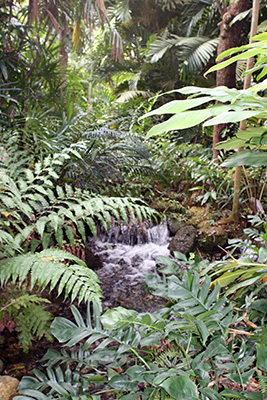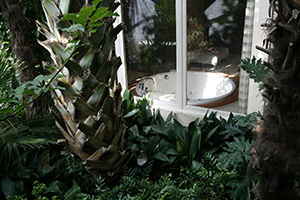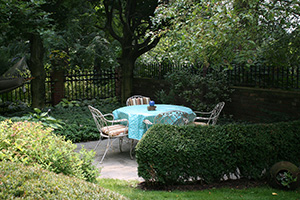A Green Oasis

When designing a garden, many people focus on colorful displays of vibrant blooms. A pallete of bright colors can be pleasant and energizing, but using various shades of green provides its own benefits. Not only is this hue easy on the human eye, it can also have a calming effect. Making this life-affirming color a primary feature in the landscape can create a tranquil scene for anyone to enjoy.
Why green?

According to the “biophilia hypothesis,” humans have an innate place in the natural world that connects us to all life on earth1. Whether you are observing your garden or walking through the forest, nature has an immense impact on our physical and emotional health. Its soothing qualities, as it turns out, are linked to the body’s response to the color green.
Natural spaces have been known to reduce stress, improve mood and even enhance creativity. Access to greenery, even as a view from the window, has been shown to speed up recovery times in hospitals and decrease the need for medication. Outdoor green spaces have been linked to increased longevity of life, allowing access to cleaner air and places to unwind and reconnect.
Green is often the dominant color in these landscapes, and research has shown the color itself has a calming effect and can reduce feelings of anger. Studies indicate that the color even lowered perception of exertion during exercise2. The hue falls in the middle of the visible spectrum and is simpler for humans to detect than other colors. As we evolved, this came in handy to identify plants and seek out potential food sources among foliage.
How to use green in the landscape

Gardeners can take advantage of these many benefits by creating an oasis of green. Foliage with green hues can create a lush retreat and foster unity in the garden. While flowers only bloom during certain times of the year, leaves often continue their display. Choosing plants for their green foliage can help liven up the landscape for longer stretches of time.
A green garden is not equivalent to a monolith—there are various hues that can add variety. Shades such as forest-green, yellow-green, blue-green, deep-green, silver-green and more can be placed in groups to create contrast. Lighter greens placed next to darker greens can create a pop of color in the landscape. You can even pair plants together in containers that complement each other. Some plants produce green flowers, such as certain species of gladiolus, chrysanthemums or hydrangeas.
Different leaf shapes and textures can add dimension and intrigue. For example, glossy green leaves like that of Southern magnolia (Magnolia grandiflora) reflect light while fuzzy leaves like those of the panda plant (Kalanchoe tomentosa) add a softness to the garden. Long, thin or whispery leaves of native grasses can add movement, and thicker foliage like that of cacti or aloe adds a rigid element. You can also vary the sizes of the plants, such as towering live oak (Quercus virginiana) or low-growing, airy ferns like southern shield fern (Thelypteris kunthii).

Make sure each species provides a function so as to create purpose and intent with your design. Tall evergreens like the native eastern red cedar (Juniperus virginiana) can protect your property from wind and erosion. In the winter, the green foliage of evergreens continues to provide color while deciduous trees lose their leaves. Groundcovers like the Florida peperomia (Peperomia obtusifolia) or cast iron plant (Aspidistra elatior) can fill a large patch of space and provide green undergrowth. Certain grasses such as native sand cordgrass (Spartina bakeri) can help with erosion and tolerate flooding. Bog plants can be placed in water-logged areas to make use of wet soil.
Designs that are too busy and chaotic are not as calming, so be mindful to limit how many species you plant. Repeated elements in the garden are soothing for the eyes and can add consistency. Using placement to create patterns with plants can add a unique flare and draw the eye to specific areas of the garden.
While urbanization has impacted our access to green spaces, the color appears among rooftop gardens, parks, roadsides and yards, and remains a respite from city sprawl. Retrofitting your space to display green more readily can get you in touch with your roots and provide peace and comfort.
Also on Gardening Solutions
More from UF/IFAS
Elsewhere on the Web
1. Gaekwad JS, Sal Moslehian A, Roös PB, Walker A. A Meta-Analysis of Emotional Evidence for the Biophilia Hypothesis and Implications for Biophilic Design. Front Psychol. 2022 May 27;13:750245. doi: 10.3389/fpsyg.2022.750245. PMID: 35693493; PMCID: PMC9186521.
2. Visual Color Perception in Green Exercise: Positive Effects on Mood and Perceived Exertion
Adam Akers, Jo Barton, Rachel Cossey, Patrick Gainsford, Murray Griffin, and Dominic Micklewright
Environmental Science & Technology
2012 46 (16), 8661-8666DOI: 10.1021/es301685g
